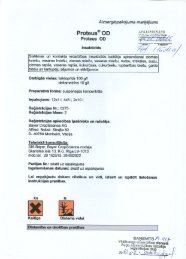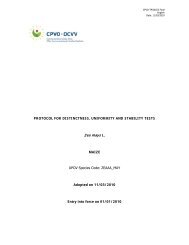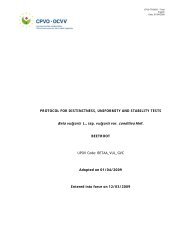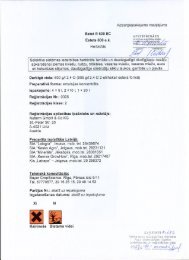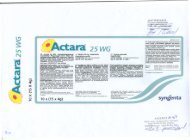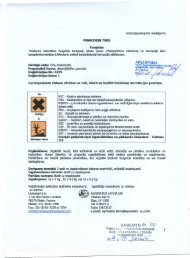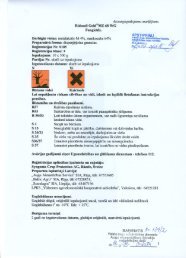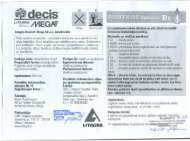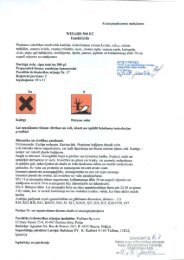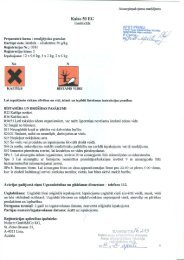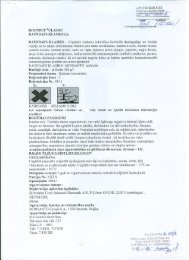CPVO Protocol for Impatiens walleriana - VAAD
CPVO Protocol for Impatiens walleriana - VAAD
CPVO Protocol for Impatiens walleriana - VAAD
Create successful ePaper yourself
Turn your PDF publications into a flip-book with our unique Google optimized e-Paper software.
<strong>CPVO</strong>-TP/011/2 Rev.EnglishDate: 01/04/2009European UnionCommunity Plant Variety OfficePROTOCOL FOR DISTINCTNESS, UNIFORMITY AND STABILITY TESTSRosa L.ROSEUPOV Species Code: ROSAAAdopted on 01/04/20091
<strong>CPVO</strong>-TP/011/2 Rev.EnglishDate: 01/04/2009I - SUBJECT OF THE PROTOCOLThe protocol describes the technical procedures to be followed in order to meet therequirement of Council Regulation 2100/94 on Community Plant Variety Rights. Thetechnical procedures have been agreed by the Administrative Council and are based ongeneral UPOV Document TG/1/3 and UPOV Guideline TG/11/8 dated 5 th April 2006<strong>for</strong> the conduct of tests <strong>for</strong> Distinctness, Uni<strong>for</strong>mity and Stability. This protocolapplies to all varieties of Rosa L. of the family Rosaceae.II - SUBMISSION OF PLANT MATERIAL1. The Community Plant Variety Office (<strong>CPVO</strong>) is responsible <strong>for</strong> in<strong>for</strong>ming theapplicant of:• the closing date <strong>for</strong> the receipt of plant material;• the minimum amount and quality of plant material required;• the examination office to which material is to be sent.The applicant is responsible <strong>for</strong> ensuring compliance with any customs and plant healthrequirements.2. Final dates <strong>for</strong> receipt of documentation and material by the Examination Office:The final dates <strong>for</strong> receipt of requests, technical questionnaires and the final dateor submission period <strong>for</strong> plant material will be decided by the <strong>CPVO</strong> and eachExamination Office chosen.The Examination Office is responsible <strong>for</strong> immediately acknowledging the receiptof requests <strong>for</strong> testing, and technical questionnaires. If no or unsatisfactory plantmaterial is submitted the <strong>CPVO</strong> should be in<strong>for</strong>med as soon as possible.3. Plant material requirements:In<strong>for</strong>mation with respect to closing dates and submission requirements of plantmaterial <strong>for</strong> the technical examination of varieties can be found on the <strong>CPVO</strong>website (www.cpvo.europa.eu) and in the special Issue S2 of the Official Gazetteof the Office published yearly in the month of September.2
<strong>CPVO</strong>-TP/011/2 Rev.EnglishDate: 01/04/2009Quality: ...................................... The plant material supplied should be visibly healthy,not lacking in vigour or affected by any important pestor disease, especially virus, as laid down in CouncilDirective 2000/29/EC and its amendments, ororganisms impairing quality as indicated in CouncilDirective 98/56/EEC and Commission Directive93/49/EEC and their amendments.The plant material must not have undergone anytreatment unless the <strong>CPVO</strong> and the examinationoffice allow or request such treatment. If it has beentreated, full details of the treatment must be givenLabelling of sample: .................. - Species- File number of the application allocated by the <strong>CPVO</strong>- Breeder’s reference- Examination reference (if known)- Name of applicant- The phrase “On request of the <strong>CPVO</strong>”.III - CONDUCT OF TESTS1. Variety collection:A variety collection will be maintained <strong>for</strong> the purpose of establishing distinctness ofthe candidate varieties in test. A variety collection may contain both living materialand descriptive in<strong>for</strong>mation. A variety will be included in a reference collection only ifplant material is available to make a technical examination.Pursuant to Article 7 of Council Regulation No. 2100/94, the basis <strong>for</strong> a collectionshould be the following:• varieties listed or protected at the EU level or at least in one of the EEA MemberStates;• varieties protected in other UPOV Member States;• any other variety in common knowledge.It is the responsibility of Examination Office to keep the variety collection up to date.2. Material to be examined:Candidate varieties will be directly compared with other candidates <strong>for</strong> Communityplant variety rights tested at the same Examination Office, and with appropriatevarieties in the variety collection. When necessary an Examination Office may alsoinclude other candidates and varieties.3
<strong>CPVO</strong>-TP/011/2 Rev.EnglishDate: 01/04/20093. Characteristics to be used:The characteristics to be used in DUS tests and preparation of descriptions shall bethose referred to in Annex 1. All the characteristics shall be used, providing thatobservation of a characteristic is not rendered impossible by the expression of anyother characteristic, or the expression of a characteristic is prevented by theenvironmental conditions under which the test is conducted. In the later case, the<strong>CPVO</strong> should be in<strong>for</strong>med. In addition the existence of some other regulation e.g.plant health, may make the observation of the characteristic impossible.The Administrative Council empowers the President, in accordance with Article 23 ofCommission Regulation N° 1239/95, to insert additional characteristics and theirexpressions in respect of a variety.4. Grouping of varieties:The varieties and candidates to be compared will be divided into groups to facilitatethe assessment of distinctness. Characteristics which are suitable <strong>for</strong> groupingpurposes are those which are known from experience not to vary, or to vary onlyslightly, within a variety and which in their various states of expression are fairlyevenly distributed throughout the collection. In the case of continuous groupingcharacteristics overlapping states of expression between adjacent groups is required toreduce the risks of incorrect allocation of candidates to groups. The characters used <strong>for</strong>grouping are the following ones:(a) Plant: growth type (characteristic 1) [G] and [P] only(b) Flower: type (characteristic 21)(c) Flower: colour group (characteristic 23)(d) Flower: diameter (characteristic 26)(e) Petal: number of colours on inner side (basal spot excluded) (characteristic 40)(f) Petal: main colour on the outer side (only if clearly different from inner side)(characteristic 50) with the following groups:Group 1: greenGroup 2: light yellowGroup 3: medium yellowGroup 4: orangeGroup 5: pinkGroup 6: redGroup 7: purple redGroup 8: brown red5. Trial designs and growing conditions:The minimum duration of tests will normally be one growing cycle if the results ondistinctness and uni<strong>for</strong>mity are conclusive. Tests will be carried out under conditionsensuring normal growth. The size of the plots will be such that plants or parts of plantsmay be removed <strong>for</strong> measuring and counting without prejudice to the observationswhich must be made up to the end of the growing period.4
<strong>CPVO</strong>-TP/011/2 Rev.EnglishDate: 01/04/2009The test design is as follows:As a minimum, each test should include a total of 6 plants <strong>for</strong> rootstock, garden andpot type varieties and a total of 9 plants <strong>for</strong> cut flower type varieties, resulting fromcrossing and 18 plants <strong>for</strong> cut flower type varieties, resulting from mutation. Separateplots <strong>for</strong> observation and <strong>for</strong> measuring can only be used if they have been subject tosimilar environmental conditions.All observations on single plants <strong>for</strong> rootstock, garden or pot type varieties determinedby measurement or counting should be made on 6 plants or parts taken from each of 6plants and any other observations made on all plants in the test.All observations on single plants <strong>for</strong> cut flower type varieties determined bymeasurement or counting should be made on 9 plants or parts taken from each of 9plants and any other observations made on all plants in the test.All observations on cut flower type varieties should be made on plants on own roots.The test should normally be conducted at one place.The test should be carried out in the open, <strong>for</strong> rootstock and garden type varieties andunder glass <strong>for</strong> pot and cut flower type varieties, under conditions ensuring normalgrowth.6. Special tests:In accordance with Article 83(3) of Council Regulation No. 2100/94 an applicant mayclaim either in the Technical Questionnaire or during the test that a candidate has acharacteristic which would be helpful in establishing distinctness. If such a claim ismade and is supported by reliable technical data, a special test may be undertakenproviding that a technically acceptable test procedure can be devised.Special tests will be undertaken, with the agreement of the President of <strong>CPVO</strong>, wheredistinctness is unlikely to be shown using the characters listed in the protocol.7. Standards <strong>for</strong> decisions:a) DistinctnessA candidate variety will be considered to be distinct if it meets the requirements ofArticle 7 of Council Regulation No. 2100/94.b) Uni<strong>for</strong>mityFor the assessment of uni<strong>for</strong>mity of vegetatively propagated varieties and seedpropagatedvarieties which are self-pollinated, a population standard of 1% with anacceptance probability of at least 95% should be applied.5
<strong>CPVO</strong>-TP/011/2 Rev.EnglishDate: 01/04/2009For a sample size between 6 and 35 plants <strong>for</strong> vegetatively propagated varieties andseed propagated varieties which are self-pollinated, only 1 off-type is allowed.For the assessment of uni<strong>for</strong>mity of seed propagated open pollinated and hybridvarieties, relative uni<strong>for</strong>mity standards should be applied.c) StabilityA candidate will be considered to be sufficiently stable when there is no evidence toindicate that it lacks uni<strong>for</strong>mity.IV - REPORTING OF RESULTSAfter each growing cycle the results will be summarised and reported to the <strong>CPVO</strong> inthe <strong>for</strong>m of a UPOV model interim report in which any problems will be indicatedunder the headings distinctness, uni<strong>for</strong>mity and stability. Candidates may meet theDUS standards after one growing cycle but in some cases two or more growing cyclesmay be required. When tests are completed the results will be sent by the ExaminationOffice to the <strong>CPVO</strong> in the <strong>for</strong>m of a UPOV model final report.If it is considered that the candidate complies with the DUS standards, the final reportwill be accompanied by a variety description in the <strong>for</strong>mat recommended by UPOV. Ifnot the reasons <strong>for</strong> failure and a summary of the test results will be included with thefinal report.The <strong>CPVO</strong> must receive interim reports and final reports by the date agreed betweenthe <strong>CPVO</strong> and the examination office.Interim reports and final examination reports shall be signed by the responsiblemember of the staff of the Examination Office and shall expressly acknowledge theexclusive rights of disposal of <strong>CPVO</strong>.V - LIAISON WITH THE APPLICANTIf problems arise during the course of the test the <strong>CPVO</strong> should be in<strong>for</strong>medimmediately so that the in<strong>for</strong>mation can be passed on to the applicant. Subject to prioragreement, the applicant may be directly in<strong>for</strong>med at the same time as the <strong>CPVO</strong>particularly if a visit to the trial is advisable.The interim report and final report shall be sent by the Examination Office to the<strong>CPVO</strong>.*******************6
<strong>CPVO</strong>-TP/011/2 Rev.EnglishDate: 01/04/2009ANNEXES TO FOLLOWANNEX IList of characteristics to be observed ............................................................... 8PAGEExplanations and methods ............................................................................... 25Legend:QL Qualitative characteristicQN Quantitative characteristicPQ Pseudo-qualitative characteristic(a) - (c) See Explanations on the Table of characteristics(+) See Explanations on the Table of characteristics[C][G][P](C)(G)(P)to be examined in cut-flower type trialto be examined in garden type trialto be examined in pot type trialcut-flower typegarden typepot-rose typeLiterature .......................................................................................................... 34ANNEX IITechnical questionnaire7
<strong>CPVO</strong>-TP/011/2 Rev.EnglishDate: 01/04/2009ANNEX ITABLE OF CHARACTERISTICS<strong>CPVO</strong>N°UPOVN°Characteristics Examples Note1. 1. [G][P]2. 2.(+)Plant: growth typePQ miniature 1[G][P]Excluding varietieswith growth typeclimber: Plant: growthhabitdwarf Korverlandus (G) 2bed Taneidol (G) 3shrub Kolmag (G) 4climber Noasafa (G) 5ground cover Meifafio (G) 6QN upright Poulhi008 (P) 1semi upright Tantasch (G); Korkallet (P) 3intermediate Poulkrid (G); Evera107 (P) 5moderatelyspreadingMeibonrib (G) 73. 3. [C][G[Plant: height (duringsecond flush)strongly spreading Korkilgwen (G) 9QN very short Lenwiga (G) 1short Noason (G) 3medium Macrexy (G); Ruiy5451 (C) 5tall Seliron (C); Tanakinom (G) 7very tall Macyefre (G) 94. 4.(+)Young shoot:anthocyanin colorationQL absent Poulans (G); Poulra019 (P) 1presentRuirovingt (C); Taneidol(G); Ruiy1549 (P)98
<strong>CPVO</strong>-TP/011/2 Rev.EnglishDate: 01/04/2009<strong>CPVO</strong>N°UPOVN°Characteristics Examples Note5. 5.(+)Young shoot: intensityof anthocyanincolorationQNvery weakPresur (C); Poulen003 (G);Poulpollo (P)1weakRuirovingt (C);Baipeace (G); Ruitrot (P)3mediumSchetroje (C); Noala (G);Delpajor (P)5strongSelaurum (C); Korozon (G);Korbigman (P)7very strongPekcoujenny (C);TAN96051 (G)96. 6. Stem: number ofprickles (excluding verysmall and hair-likeprickles )QN absent or very few Ruiorg (G); Meibegil (P) 1fewmediumSchremna (C);Kortionza (G);Poulcolop (P)Selaurum (C);Bokramar (G); Kormisso (P)35many Meineble (G); Evera105 (P) 7very many Deljam (G) 97. 7. Prickles: predominantcolour (as <strong>for</strong> 6)PQ(a)greenishPresur (C); Kolmag (G);Poulcar (P)1yellowish Ruiy0775 (P) 2reddish Bokrarug (G); Delpajor (P) 3purplish Kornairol (G); Evera102 (P) 49
<strong>CPVO</strong>-TP/011/2 Rev.EnglishDate: 01/04/2009<strong>CPVO</strong>N°UPOVN°Characteristics Examples Note8. 8. Leaf: sizeQN(a)smallPredesplen (C);Kordenzen (G); Ruibrei (P)3mediumPekcoujenny (C);Tantasch (G);Korrecalam (P)5large Poultime (G); Poulhi018 (P) 79. 9. Leaf: intensity of greencolour (upper side)QN(a)lightInterlis (C); Tanjuwe (G);Evergreen (P)3mediumKorplapei (C); Poulrus (G);Korrecalam (P)5dark Korparesni (G); Poulflag (P) 710. 10. [G][P]Leaf: anthocyanincolorationQL(a)absentPoulac005 (G);Meikilaylo (P)1present Kornairol (G); Evera102 (P) 911. 11. Leaf: glossiness ofupper sideQN (a) absent or veryweakSomnip (G); Evera105 (P) 1weakmediumstrongKorcilmo (C);Meilauron (G);Korscherki (P)Interlis (C); Dicmoust (G);Ruiy0775 (P)Pekcoujenny (C);Wekpaltlez (G);Poulhi008 (P)357very strong 910
<strong>CPVO</strong>-TP/011/2 Rev.EnglishDate: 01/04/2009<strong>CPVO</strong>N°UPOVN°Characteristics Examples Note12. 12. Leaflet: undulation ofmarginQN (a) absent or veryweakPoulaksel (G); Poulyn (P) 1weakmediumstrongKorcilmo (C);Meihecluz (G); Delpajor (P)Ruirovingt (C);Korkilgwen (G);Korbigman (P)Predepass (C);Noatraum (G); Ruiz0123 (P)357very strong 913. 13. Terminal leaflet: shapeof bladePQ(a)narrow ellipticKorverlandus (G);Ruiz29924 (P)1medium ellipticKorflapei (C);Meihuterb (G);Ruiz14914 (P)2ovateInterlis (C); Noahan (G);Evera102 (P)3circular Poulna (G) 414. 14.(+)[C]Terminal leaflet: shapeof base of bladePQ (a) acute Tanotika (C) 1obtuse Schetroje (C) 2rounded Korcilmo (C) 3cordate 411
<strong>CPVO</strong>-TP/011/2 Rev.EnglishDate: 01/04/2009<strong>CPVO</strong>N°UPOVN°Characteristics Examples Note15. 15.(+)Terminal leaflet: shapeof apex of bladePQ(a)acuminateMeihuterb (G);Poulberty (P)1acuteInterlis (C); Heleva (G);Kormutric (P)2obtuse Pekcourofondu (G) 3roundedRuirovingt (C);Tantumleh (G)416. 16.(+)[G][P]Flowering shoot:flowering lateralsQL absent 1present 917. 17.(+)[G][P]Flowering shoot:number of floweringlateralsQN very few 1few Tanidrak (G); Poulra022 (P) 3medium Dicentice (G); Poulhi019 (P) 5many Korgazell (G); Ruiy0775 (P) 7very many Korglolev (P) 918. 18.(+)[G][P]Only varieties with noflowering laterals:Flowering shoot:number of flowersvery few 1few 3medium 5many 7very many 912
<strong>CPVO</strong>-TP/011/2 Rev.EnglishDate: 01/04/2009<strong>CPVO</strong>N°UPOVN°Characteristics Examples Note19. 19.(+)[G][P]Only varieties withflowering laterals:Flowering shoot:number of flowers perlateralQN very few Somnip (G); Ruiklinko (P) 1few Noaley (G); Korselug (P) 3medium Poulanlis (G); Poulbao (P) 5manyTAN97274 (G);Ruitween (P)7very many Noamet (G); Poulra017 (P) 920. 20.(+)[G][P]Flower bud: shape inlongitudinal sectionPQellipticRuivierneg (G);Poulra021 (P)1medium ovate Noasafa (G); Evergreen (P) 2broad ovateMeisardan (G);Korstrunek (P)321. 21.(+)[G][P]Flower: typeQN (b) single Noastrauss (G) 1semi-double Poulfiry (G); Poulnil (P) 2doubleTAN97103 (G);Korlobea (P)322. 22. Flower: number ofpetalsQN (b) very few Noala (G); Delmitaf (P) 1fewmediummanyPredesplen (C);Tananilov (G);Korbersoma (P)Ruiy5451 (C);Poulscots (G); Ruiklinko (P)Lexani (C); Ruiharl (G);Meiraktas (P)357very many Meiroupis (G); Poulwen (P) 913
<strong>CPVO</strong>-TP/011/2 Rev.EnglishDate: 01/04/2009<strong>CPVO</strong>N°UPOVN°Characteristics Examples Note23. 23.(+)Flower: colour groupPQ(b)white or nearwhiteKorcilmo (C);Meilontig (G);Poulra022 (P)1white blendSpeclown (C);TAN98505 (C);TAN97123 (G); Rush (G)2greenNirpgreenl (C);Korewala (P)3yellowKorflapei (C);Poulyc004 (G); Delmitaf (P)4yellow blendTAN00125 (C); Rumba (G);Ruiabri (P)5orange Alsever (P); Tanoranbon(G) 6orange blend Presur (C); Meishulo (P) 7pinkpink blendredred blendred purpleSchremeen3001 (C);Noasia (G); Korfonsova (P)Schremna (C);Korfeining (G);Poulmeno (P)Predepass (C);Noafeuer (G); Ruikenre (P)Meilambra (C) ;Interuspa (G); Delmigre (P)Nirpillpro (C);Poulac016 (P)89101112purple Olyung (C); Stebigpu (G) 13violet blend Scholtec (C); Korflieder (P) 14brown blend Simcho (G) 15multicoloured Delmitaf (P) 1614
<strong>CPVO</strong>-TP/011/2 Rev.EnglishDate: 01/04/2009<strong>CPVO</strong>N°UPOVN°Characteristics Examples Note24. 24.(+)[G]Varieties with doubleflowers only: Flower:colour of the centrePQ (b) green 1yellow 2orange 3pink 4red 5purple 625. 25. [G][P]Varieties with doubleflowers only: Flower:density of petalsQN (b) very loose 1loose Interladru (G) 3mediumMeitrainaz (G);5denseAusencart (G);Poulhi017 (P)726. 26. Flower: diameterQN (b) very small Noastrauss (G); Poulset (P) 1smallmediumlargevery largeInterlis (C);Climbing Canibo (G);Meiraktas (P)Schremna (C); Poulberg (G);Ruiz1491 (P)Selaurum (C);Adesmanod (G);Korewala (P)Koranderer (G);Evera116 (P)357915
<strong>CPVO</strong>-TP/011/2 Rev.EnglishDate: 01/04/2009<strong>CPVO</strong>N°UPOVN°Characteristics Examples Note27. 27.(+)Flower: shapePQ(b)roundRuirovingt (C);Meiouscki (G);Evera101 (P)1irregularlyroundedRuyi5451 (C);Kormarec (G); Korkallet (P)2star-shapedPredesplen (C);Anakissi (G);Poulra023 (P)328. 28.(+)[C][G]Flower: profile ofupper partPQ (b) flat Ausmol (G); Interlis (C) 1flattened convexPekcoujenny (G);Ruyi5451 (C)2convex Jacakor (G) 329. 29.(+)[C][G]Flower: profile of lowerpartPQ(b)concaveAushunter (G);Selaurum (C)1flatMeitonje (G);Predesplen (C)2flattened convexKorflapei (C);Meironsse (G)3convex Jacare (G) 430. 30. Flower: fragranceQN(b)absent or weakPredesplen (C);Ruimats (G); Evera107 (P)1medium Poulsolo (G); Korduftoro (P) 2strong Tananilov (G) 316
<strong>CPVO</strong>-TP/011/2 Rev.EnglishDate: 01/04/2009<strong>CPVO</strong>N°UPOVN°Characteristics Examples Note31. 31.(+)Sepal: extensionsQN (b) absent or veryweakPouldron (G); Ruirowho (P) 1weakmediumstrongInterlis (C); Ruiharl (G);Everos (P)Predesplen (C);Tankissi (G); Ruiklinko (P)Spekes, Pekcoujenny (C);Meipeluj (G); Koranalafi (P)357very strong 932. 32.(+)Petals: reflexing ofpetals one-by-oneQL(b)absentMeidonets (G);Poulberty (P)1(c ) present Baipeace (G); Korpidanz (P) 933. 33. Petal: shapePQ (b) elliptic 1(c) transverse elliptic Selaurum (C) 2obovate Korcilmo (C) 3obcordate 4roundedSchremna (C);Meihecluz (G);Poulac002 (P)534. 34. Petal: incisionsQN (b) absent or veryweakTAN98130 (G) 1(c)weakSelaurum(C);Poulac008 (G); Poulneto (P)3medium Ruirovingt (C); Reubis (G) 5strong Interladru (G) 7very strong 917
<strong>CPVO</strong>-TP/011/2 Rev.EnglishDate: 01/04/2009<strong>CPVO</strong>N°UPOVN°Characteristics Examples Note35. 35. Petal: reflexing ofmarginQN (b) absent or veryweakAusjame (C); Noaheim (G);Asia (P)1(c)weakKoretyal (C);Kortwente (G); Delpajor (P)3mediumSchremna (C);Poulduce (G); Ruiklinko (P)5strongPredesplen (C);Ruivierneg (G);Poulra023 (P)7very strongSelaurum (C);Tanziewsim (G);Korduftoro (P)936. 36. Petal: undulationQN (b) absent or veryweakAusjame (C); Ruisjkol (G);Poulbao (P)1(c)weakRuiy5451 (C);Meilauron (G);Ruirowho (P)3mediumSchremna (C); Poulgelb (G);Evera101 (P)5strongKoretyal (C); Delpabra (G);Poulra023 (P)7very strong Korbraufo (G) 937. 37. [G][P]Petal: sizeQN very small Poulemb (G) 1(b) small Ruibleu (G); Meishulo (P) 3(c)mediumTanweisa (G);Korbigman (P)5large Meimucas (G); Evera116 (P) 7very large Pekcoufeudor (G) 918
<strong>CPVO</strong>-TP/011/2 Rev.EnglishDate: 01/04/2009<strong>CPVO</strong>N°UPOVN°Characteristics Examples Note38. 38. [C] Petal: lengthQN (b) very short 139. 39. [C] Petal: width(c) short Interlis (C) 3medium Predesplen (C) 5long Selaurum (C) 7very long 9QN (b) very narrow 1(c) narrow Interlis (C) 340. 40. Petal: number ofcolours on inner side(basal spot excluded)medium Predesplen (C) 5broad Selaurum (C) 7very broad 9QL(b)oneSelaurum (C);TAN98130 (G); Ruibrei (P)1(c) two Baipeace (G); Delki (P) 241. 41. Only varieties with onecolour on inner side ofpetal: Petal: intensity ofcolour (basal spotexcluded)more than two Delstrisang (G) 3QN (b) lighter towardsthe baseInterlis (C); Poulen012 (G);Ruiz29924 (P)1(c)evenSelaurum (C);TAN98130 (G);Poulra017 (P)2lighter towardsthe topPredesplen (C);Orasoglo (G); Poulhi002 (P)319
<strong>CPVO</strong>-TP/011/2 Rev.EnglishDate: 01/04/2009<strong>CPVO</strong>N°UPOVN°Characteristics Examples Note42. 42. Petal: main colour onthe inner side (maincolour is that withlargest surface area)PQ(b)(c)RHS Colour Chart (indicate reference number)43. 43. Only varieties with twoor more colours oninner side of petal:Petal: secondary colour(basal spot excluded)PQ(b)(c)RHS Colour Chart (indicate reference number)44. 44. Only varieties withmore than two colourson inner side of petal:Petal: tertiary colour(basal spot excluded)PQ (b) white 1(c) green 2light yellow 3medium yellow Delstrisang (G) 4orange 5pink 6red 7purple red 8brown red 9purple 1020
<strong>CPVO</strong>-TP/011/2 Rev.EnglishDate: 01/04/2009<strong>CPVO</strong>N°UPOVN°Characteristics Examples Note45. 45.(+)Only varieties with twoor more colours oninner side of petal:Petal: distribution ofsecondary colour oninner side (basal spotexcluded)PQ (b) at base 1(c) at apex 2at marginal zonePanhurem (G);Korbuntea (P)3as a flush Wekquaneze (G) 4as segments orstripesDelstrisang (G):Delmigre (P)5as speckles 646. 46.(+)Only varieties withmore than two colourson inner side of petal:Petal: distribution oftertiary colour on innerside (basal spotexcluded)PQ (b) at base 1(c) at apex 2at marginal zone 3as a flush 4as segments orstripesDelstrisang (G) 5as speckles 647. 47. Petal: basal spot on theinner sideQL(b)absentKorflapei (C); Pouldom (G);Korewala (P)1(c)presentRuirovingt (C);Meipeluj (G);Poulper029 (P)921
<strong>CPVO</strong>-TP/011/2 Rev.EnglishDate: 01/04/2009<strong>CPVO</strong>N°UPOVN°Characteristics Examples Note48. 48.(+)Petal: size of basal spoton inner sideQN (b) very small Seliron (C); Evera104 (P) 1(c)smallRuiy5451 (C); Noawel (G);Korrovino (P)3mediumPresur (C); Kordenzen (G);Poulhi008 (P)5largePoulmanti (G);Koranalafii (P)7very large Tanispil (G) 949. 49. Petal: colour of basalspot on inner sidePQ(b)whiteSeliron (C); Speruge (G);Ruiz0206 (P)1(c)greenishInterlis (C); Korkopap (G);Poulra002 (P)2light yellowSchremna (C); Poulerry (G);Korpidanz (P)3medium yellowRuiy5451 (C); Stebigpu (G);Korbever (P)4orange yellowSelaurum (C); Korsetag (G);Poulnil (P)5orange Tanziewsim (G); Poulfio (P) 650. 50. Petal: main colour onthe outer side (only ifclearly different frominner side)PQ(b)(c)RHS Colour Chart (indicate reference number)22
<strong>CPVO</strong>-TP/011/2 Rev.EnglishDate: 01/04/2009<strong>CPVO</strong>N°UPOVN°Characteristics Examples Note51. 51. Outer stamen:predominant colour offilamentPQ(b)whiteHelklewi (G);Koralbavan (P)1greenInterlis (C); Kornemuta (G);Kornemut (P)2light yellow Pouljill (G) 3medium yelloworangeKorplapei (C);Meikrotal (G);Meirosfon (P)Ruiy5451 (C);Ruiskopoul (G);Everrom (P)45pink Korfasso (G); Ruiowko (P) 6redPredesplen (C);Pekoucan (G); Espever (P)7brown red Schweizer Woche (G) 8purple Heltscher (G); Ruiovat (P) 952. 52. [G] Seed vessel: size (atpetal fall)53. 53.(+)QN very small 1[G]Hip: shape inlongitudinal sectionsmall Poulemb (G) 3medium Kolmag (G) 5large Super Dagmar (G) 7very large 9PQ funnel-shaped Meidrason (G) 1pitcher-shaped Korparesni (G) 2pear-shaped Tanzahde (G) 323
<strong>CPVO</strong>-TP/011/2 Rev.EnglishDate: 01/04/2009<strong>CPVO</strong>N°UPOVN°Characteristics Examples Note54. 54.(+)[G]Hip: colour (at maturestage)PQ yellow 1orange 2red 3brown 4black 524
<strong>CPVO</strong>-TP/011/2 Rev.EnglishDate: 01/04/2009EXPLANATIONS AND METHODSExplanations covering several characteristicsCharacteristics containing the following key in the second column of the Table ofCharacteristics should be examined as indicated below:(a)(b)(c)Observations on the leaves and the leaflets should be made on the middle third of thestem.Observations on the flower which should be made on a just fully “opened” flower (atthe time of anther dehiscence).Observations on the petal which should be made on:Double flowers: on a petal from the 3rd outer whorl.Semi double flowers: on a petal from the middle whorl.Explanations <strong>for</strong> individual characteristicsAd. 2: Excluding varieties with growth type climber: Plant: growth habit1 3 5upright semi upright intermediate7 9moderately spreadingstrongly spreading25
<strong>CPVO</strong>-TP/011/2 Rev.EnglishDate: 01/04/2009Ad. 4: Young shoot: anthocyanin colorationAd. 5: Young shoot: intensity of anthocyanin colorationObservations should be made on the distal third of a shoot with a length of approximately20 cm. The leaves should be included in the observations.Ad. 14: Terminal leaflet: shape of base of blade1 2 3 4acute obtuse rounded cordateAd. 15: Terminal leaflet: shape of apex of blade1 2 3 4acuminate acute obtuse rounded26
<strong>CPVO</strong>-TP/011/2 Rev.EnglishDate: 01/04/2009Ad. 16: Flowering shoot: flowering laterals1 9absentpresentAd. 17: Flowering shoot: number of flowering lateralsAd. 18: Only varieties with no flowering laterals: Flowering shoot: number of flowersAd. 19: Only varieties with flowering laterals: Flowering shoot: number of flowers per lateralAd. 17 Ad. 18Ad. 19Ad. 20: Flower bud: shape in longitudinal sectionObservations should be made just be<strong>for</strong>e the separation of the sepals.27
<strong>CPVO</strong>-TP/011/2 Rev.EnglishDate: 01/04/2009Ad. 21: Flower: typesingle ................................ maximum of 7 petalssemi-double ...................... 8 to 20 petalsdouble ............................... more than 20 petalsAd. 23: Flower: colour groupBlend means a smooth transition between colours. For multicoloured varieties there are sharplydefined contrasting zones.2: white blend: includes varieties which are primarily white, but show some tones of some other hues(like pink, red, red pink, purple).5: yellow blend: includes varieties which are primarily yellow, but show some tones of some otherhues (like pink, red, red pink).7: orange blend: includes varieties which are primarily orange, but show some tones of some otherhues (like yellow, purple).9: pink blend: includes varieties which are primarily pink, but show some tones of some other hues(like orange, yellow, purple)11: red blend: includes varieties which are primarily red, but show some tones of some other hues(like yellow, orange).14: violet blend: includes varieties which are primarily violet but show some tones of some other hues(like mauve and/or lavender).15: brown blend: includes varieties which are primarily brown but show some tones of some otherhues (like red)16: multicoloured: varieties with more than one colour in sharply defined contrasting zones (not blendcolours).Ad. 24: Varieties with double flowers only: Flower: colour of the centreOnly varieties with a clearly defined colour difference between the centre of the flower and the outerpart of the flower, viewed from above.28
<strong>CPVO</strong>-TP/011/2 Rev.EnglishDate: 01/04/2009Ad. 27: Flower: shape1 2 3round irregularly rounded star-shapedAd. 28 : Flower: profile of upper part1 2 3flat flattened convex convex29
<strong>CPVO</strong>-TP/011/2 Rev.EnglishDate: 01/04/2009Ad. 29: Flower: profile of lower partAd. 31: Sepal: extensions1 3 5 7 9absent or weak medium strong very strongvery weak30
<strong>CPVO</strong>-TP/011/2 Rev.EnglishDate: 01/04/2009Ad. 32: Petals: reflexing of petals one-by-oneExample over a period of time of a variety where the petals open simultaneously, i.e. petals reflexingone-by-one is absent.Time1absentExample over a period of time of a variety where the petals reflex one-by-one.Time9presentAd. 45: Only varieties with two or more colours on inner side of petal: Petal distribution ofsecondary colour on inner side (basal spot excluded)Ad. 46: Only varieties with two or more colours on inner side of petal: Petal: distribution of tertiarycolour on inner side (basal spot excluded)1 2 3 4 5 6at base at apex at marginal as a flush as segments as speckleszoneor stripes31
<strong>CPVO</strong>-TP/011/2 Rev.EnglishDate: 01/04/2009Ad. 48: Petal: size of basal spot on inner sideMarginal zoneMiddle zoneBasal spotAd. 53: Hip: shape in longitudinal section1 2 3funnel-shaped pitcher-shaped pear-shapedAd 54: Hip: colour (at mature stage)Varieties grown <strong>for</strong> hips only.32
<strong>CPVO</strong>-TP/011/2 Rev.EnglishDate: 01/04/2009Growing typesIt may be necessary <strong>for</strong> separate growing trials to be established <strong>for</strong> cut-flower types, gardentypes and pot types in order to ensure the satisfactory growth of varieties of those types. Thefollowing in<strong>for</strong>mation is provided with regard to growing conditions <strong>for</strong> different types ofvarieties and in<strong>for</strong>mation which may help in deciding on the type of trial(s) which may beappropriate <strong>for</strong> a variety:Cut-flower types:Breeding is done in a limited gene pool. In general, such types of variety belong to the HybridTea Roses and have the following features:• not very tolerant to low temperatures: heated greenhouses required <strong>for</strong> good cropdevelopment in temperate zones;• protection needed against sun or rain, in warm climates;• disbudding, in order to produce one large flower per stem, always necessary byremoving the lateral branches in the inflorescence and <strong>for</strong> spray varieties by removingthe terminal flower;• usually having less and smaller prickles than garden and pot rose types;• most cut-flower types have double flowers, but are sometimes semi-double.Garden types:Breeding is done in a rather large gene pool, in most cases much broader and different fromthe other types. In general, such types of variety have the following features:• tolerant of lower temperatures in general;• type and size of prickles less or not important compared to cut-flower and pot types(breeding is sometimes focussed on large prickles often of a contrasting colour);• all flower types (single, semi-double and double) can be seen in garden types;• growth habit varies from narrow bushy to creeping;• includes container and patio roses as well as rootstock varieties.Pot typesBreeding is mainly done in a gene pool which is different from the cut-flower and gardentypes. In general, such types of variety have the following features:• concerns only types used as houseplants and produced in greenhouses or othersheltered conditions;• plants with limited plant height and diameter;• nearly always have semi-double or double flowers:• do not include container and / or patio roses, which should be treated as garden types.33
<strong>CPVO</strong>-TP/011/2 Rev.EnglishDate: 01/04/2009LITERATURECharles Quest-Ritson and Brigit Quest-Ritson: American Rose Society Encyclopedia ofRoses; American Rose Soc., ISBN 07894996755Margaret Olds. 1998 (Managing Editor): Botanica’s Roses - The Encyclopedia of Roses,Random House Australia Pty, ISBN 1566491762 – Raincost Books Vancouver BC Canada,704 ppPeter Beales, September 1997: Classic Roses: An Illustrated Encyclopedia and GrowersManual of Old Roses, Shrub Roses and climbers, ISBN 0805055843, Timber PressPeter Schneider, 2004: Combined Rose List 2004, The International Rose Directory, P.O. Box677, Mantua, OH 44255 USAThomas Debener and Prof. Serge Gudin, 2003: Encyclopedia of Rose Science 3 Volume Set,ed. Prof. Andrew Roberts, dr. Academic Press Oct. 2003, ISBN 0122276205Academic Press New York, 2000: Modern roses X1, The World Encyclopedia of Roses,ISBN 0-12-155053-2Moody, Mary and Peter Harkness (eds). 1992: The Illustrated Encyclopedia of Roses, TimberPress, Portland OR: Timber Press.Nico Vermeulen, 2002: Rozenencyclopedie, Rebo Productions 2002, ISBN 903661341834
<strong>CPVO</strong>/TQ-011-ENDate: 01/04/2009ANNEX IIEuropean UnionCommunity Plant Variety OfficeTECHNICAL QUESTIONNAIREto be completed in connection with an application <strong>for</strong> Community Plant Variety RightsPlease answer all questions. A question without any answer will lead to a non-attributionof an application date. In cases where a field / question is not applicable, please state so.1. Botanical taxon: Name of the genus, species or sub-species to which the variety belongs and commonnameRosa L.ROSESpecies (indicate) …………………………… [ ]Hybrid complex [ ]2. Applicant(s): Name(s) and address(es), phone and fax number(s), Email address, and where appropriatename and address of the procedural representative………………………………3. Variety denominationa) Where appropriate proposal <strong>for</strong> a variety denomination:………………b) Provisional designation (breeder’s reference):………………Page 1
<strong>CPVO</strong>/TQ-011-ENDate: 01/04/20094. In<strong>for</strong>mation on origin, maintenance and reproduction of the variety4.1 Origin(a) Seedling (indicate parent varieties) ........................................ [ ]............................................................................................................................................................................................................................................................................................................................................................................................................................................................................................................................................................................................................................................................................................................................................................(b) Mutation (indicate parent variety) .......................................... [ ]............................................................................................................................................................................................................................................................................................................................................................................................................................................................................................................................................................................................................................................................................................................................................................(c)Discovery (indicate where, whenand how the variety has been developed): .............................. [ ]............................................................................................................................................................................................................................................................................................................................................................................................................................................................................................................................................................................................................................................................................................................................................................(d) Other (please specify) ............................................................ [ ]............................................................................................................................................................................................................................................................................................................................................................................................................................................................................................................................................................................................................................................................................................................................................................Page 2
<strong>CPVO</strong>/TQ-011-ENDate: 01/04/20094.2 Method of propagation(a) Grafting (indicate rootstock) .................................................. [ ](b) Cuttings .................................................................................. [ ](c) In vitro propagation ................................................................ [ ](d) Other (please specify): .......................................................... [ ]........................................................................................................................................................................................................................................................................................................................................................................................................................................................................................................4.4 Geographical origin of the variety: the region and the country in which the variety was bred ordiscovered and developed………………………………………………………………………………….………5. Characteristics of the variety to be indicated (the number in brackets refers to the correspondingcharacteristic in the <strong>CPVO</strong> <strong>Protocol</strong>; please mark the state of expression which best corresponds).Characteristics Example varieties Note5.1(1)Plant: growth typeminiature 1 [ ]dwarf Korverlandus (G) 2 [ ]bed Taneidol (G) 3 [ ]shrub Kolmag (G) 4 [ ]climber Noasafa (G) 5 [ ]ground cover Meifafio (G) 6 [ ]5.2(21)Flower: typesingle Noastrauss (G) 1 [ ]semi-double Poulfiry (G); Poulnil (P) 2 [ ]double TAN97103 (G); Korlobea (P) 3 [ ]Page 3
<strong>CPVO</strong>/TQ-011-ENDate: 01/04/2009Characteristics Example varieties Note5.3(23)Flower: colour groupwhite or near whitewhite blendKorcilmo (C); Meilontig (G);Poulra022 (P)1 [ ]Spelclown (C); TAN98505 (C);TAN 97123 (G); Rush (G) 2 [ ]green Nirpgreenl (C); Korewala (P) 3 [ ]yellowyellow blend(includes varieties which are primarilyyellow, but show some tones of someother hues)Korflapei (C); Poulyc004 (G);Delmitaf (P)TAN00125 (C); Rumba (G);Ruiabri (P)4 [ ]5 [ ]orange Alsever (P); Tanoranbon (G) 6 [ ]orange blend(includes varieties which are primarilyorange, but show some tones of someother hues)pinkpink blend(includes varieties which are primarilypink, but show some tones of some otherhues)redPresur (C); Meishulo (P) 7 [ ]Schremeen3001 (C);Noasia (G); Korfonsova (P)Schremna (C); Korfeining (G)Poulmeno (P)Predepass (C); Noafeuer (G);Ruikenre (P)8 [ ]9 [ ]10 [ ]red blend(includes varieties which are primarilyred, but show some tones of some otherhues)Meilambra (C); Interuspa (G);Delmigre (P)11[ ]red purple Nirpillpro (C); Poulac016 (P) 12 [ ]purple Olyung (C); Stebigpu (G) 13 [ ]violet blend(includes varieties which are primarilyviolet but show some tones of some otherhues (like mauve and/or lavender)brown blend(includes varieties which are primarilybrown but show some tones of some otherhues (like red)multicolored(varieties with more than one colour insharply defined contrasting zones (notblend colours))Scholtec (C); Korflieder (P) 14 [ ]Simcho (G) 15 [ ]Delmitaf (P) 16 [ ]Page 4
<strong>CPVO</strong>/TQ-011-ENDate: 01/04/2009Characteristics Example varieties Note5.4(26)Flower: diametervery small Noastrauss (G); Poulset (P) 1 [ ]smallmediumlargeInterlis (C); Clb.canibo 82 (G);Meiraktas (P)Schremna (C); Poulberg (G);Ruiz1491 (P)Selaurum (C); Adesmanod (G);Korewala (P)3 [ ]5 [ ]7 [ ]very large Koranderer (G); Evera116 (P) 9 [ ]5.5(40)Petal: number of colours on inner side(basal spot excluded)oneSelaurum (C), TAN98130 (G);Ruibrei (P)1 [ ]two Baipeace (G); Delki (P) 2 [ ]more than two Delstrisang (G) 3 [ ]Please fill in point (i) if possible, otherwise point (ii).5.6(i)(50)Petal: main colour on the outer side(only if clearly different from innerside)RHS Colour Chart (indicate reference number): ........................................5.6(ii)(50)Petal: main colour on the outer side(only if clearly different from innerside)green 1 [ ]light yellow 2 [ ]medium yellow 3 [ ]orange 4 [ ]pink 5 [ ]red 6 [ ]purple red 7 [ ]brown red 8 [ ]Other colour (indicate): …………………………. 9 [ ]Page 5
<strong>CPVO</strong>/TQ-011-ENDate: 01/04/20096. Similar varieties and differences from these varieties:Denomination ofsimilar varietyCharacteristic in which thesimilar variety is different 1)State of expressionof similar varietyState of expression ofcandidate variety____________1)In the case of identical states of expressions of both varieties, please indicate the size of the difference7. Additional in<strong>for</strong>mation which may help to distinguish the varietyA representative printed-out colour photo of the variety must be added to the Technical Questionnaire.7.1 Resistance to pests and diseases………………7.2 Special conditions <strong>for</strong> the examination of the variety7.2.1 GroupHip rose .............................................................................. [ ]Garden rose ........................................................................ [ ]Pot rose ............................................................................... [ ]Greenhouse rose <strong>for</strong> cut-flower production ....................... [ ]Rootstock ........................................................................... [ ]Other (indicate) .................................................................. [ ]........................................................................................................................................................................................................................................................................................................................................................................................................................................................................................................................................................................................................................................................................................................Page 6
<strong>CPVO</strong>/TQ-011-ENDate: 01/04/20097.2.2 Cultivation type in case of greenhouse roseSpray .................................................................................. [ ]One flower per stem ........................................................... [ ]7.2.3 Other conditions[ ] YES, please specify: ……………………….………[ ] NO7.3 Other in<strong>for</strong>mation[ ] YES, please specify: ……………………….………[ ] NO8. GMO-in<strong>for</strong>mation requiredThe variety represents a Genetically Modified Organism within the meaning of Article 2(2) of CouncilDirective EC/2001/18 of 12/03/2001.[ ] YES [ ] NOIf yes, please add a copy of the written attestation of the responsible authorities stating that a technicalexamination of the variety under Articles 55 and 56 of the Basic Regulation does not pose risks to theenvironment according to the norms of the above-mentioned Directive.Page 7
<strong>CPVO</strong>/TQ-011-ENDate: 01/04/20099. In<strong>for</strong>mation on plant material to be examined9.1 The expression of a characteristic or several characteristics of a variety may be affected by factors, suchas pests and disease, chemical treatment (e.g. growth retardants or pesticides), effects of tissue culture,different rootstocks, scions taken from different growth phases of a tree, etc.9.2 The plant material should not have undergone any treatment which would affect the expression of thecharacteristics of the variety, unless the competent authorities allow or request such treatment. If the plantmaterial has undergone such treatment, full details of the treatment must be given. In this respect, pleaseindicate below, to the best of your knowledge, if the plant material to be examined has been subjected to:(a) Micro-organisms (e.g. virus, bacteria, phytoplasma) [ ] Yes [ ] No(b) Chemical treatment (e.g. growth retardant or pesticide) [ ] Yes [ ] No(c) Tissue culture [ ] Yes [ ] No(d) Other factors [ ] Yes [ ] NoPlease provide details of where you have indicated “Yes”:…………………………………………………………………………………………………………………………………………………………………………………………………………………………………………………………………………………………………………………………………………………………………………………………………………………………………………………………………………………………………………………………………………………………………………………………………………………………………………………………………………………………………………………………………………………………………………………………………………………………………………………………………………………………………………………………………………………………………………………………………………………………………………………………………………………………………………………………………………………………………………………………………………………………………………………………………………………………………………………………………………………………………………………………………………………………………………………………………………………………………………………………………………………………………………………………………………………………………………………………………………………………………………………………………………………………………………………………………………………………………………………………………………………………………………………………………………………………………………………………………………………………………………………………………………………………………………………………………………………………………………………………………………………………………………………………………………………………………………………………………………………………………………………………………………………………………………I/we hereby declare that to the best of my/our knowledge the in<strong>for</strong>mation given in this <strong>for</strong>m is complete andcorrect.Date Signature Name[End of document]Page 8





